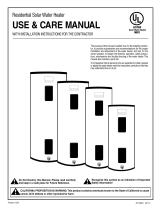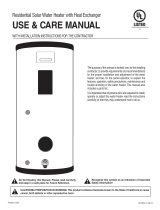
49-50336 Rev. 0 7
Routine Preventive Maintenance
DANGER
Risk of Scald - Before manually
operating the relief valve, make certain no one will
be exposed to the danger of coming in contact with
the hot water released by the valve. The water may
be hot enough to create a scald hazard. The water
should be released into a suitable drain to prevent
injury or property damage.
NOTE: If the temperature and pressure-relief valve
on the hot water heater discharges periodically, this
may be due to thermal expansion in a closed water
system. Contact the water supplier or your plumbing
contractor on how to correct this. Do not plug the
relief valve outlet.
Properly maintained, your water heater will provide years
of dependable trouble-free service. It is suggested that
the following annual preventive maintenance program be
established.
1. Inspect Temperature & Pressure Relief Valve.
2. Inspect heating elements, ECO, and wiring to each.
3. Drain and Flush the water heater tank.
4. Anode rod must be removed and inspected.
Temperature and Pressure-Relief Valve:
Once a year, it is recommended to lift and release the
lever handle on the temperature and pressure-relief
valve, located on the front-right side of the water heater,
to make certain the valve operates freely. Allow several
gallons to flush through the discharge line to an open
drain.
Heating Elements and ECO:
Once a year, it is recommended to inspect the heating
elements, ECO, and wiring to each. Inspection should
be completed by service personnel qualified in electrical
appliance repair.
Most electrical appliances, even when new, make some
sound when in operation. If the hissing or singing sound
level increases excessively, the electric heating element
may require cleaning. Contact a qualified installer or
plumber for inspection.
Draining and Flushing the Water Heater
CAUTION
Risk of Shock - Shut off power to
the water heater before draining water.
DANGER
Risk of Scald - Before manually
operating the relief valve, make certain no one will
be exposed to the hot water released by the valve.
The water drained from the tank may be hot enough
to present a scald hazard and should be directed to
a suitable drain to prevent injury or damage.
A water heater’s tank can act as a settling basin for
solids suspended in the water. It is therefore not
uncommon for hard water deposits to accumulate in the
bottom of the tank. To clean the tank of these deposits, it
is recommended to drain and flush the water heater tank
once a year. To drain the water heater, follow these
steps:
1. Turn off power to the unit. The electric heating
elements will become damaged if operated without
water.
2. Attach a garden hose to the drain valve located at the
bottom of the unit and direct that hose to a drain.
3. Turn off the cold water supply.
4. Admit air to the tank by opening a hot water faucet or
lifting the handle on the relief valve.
5. Open the drain valve.
Flushing the Tank:
1. Follow steps above to drain the water heater.
2. Once the water heater is empty, with the drain valve
open and garden hose attached to the drain valve,
turn on the cold water supply.
3. Allow several gallons to flush through the drain valve
and hose to an open drain.
4. Turn off the water supply and allow any water
remaining in the tank to drain.
5. Repeat steps 3 and 4 until water runs clear.
6. Close the drain valve and fill the tank before returning
power to the unit. The tank is full when water runs out
of a nearby open hot water faucet.
Flushing should be done with an empty tank to promote
additional removal of sediment.
NOTE: See page 11 for product schematic.
CARE AND CLEANING
Care and Cleaning
Exterior Surfaces
Hand wash with damp cloth, using only warm water. Wipe dry using a dry, clean cloth.
Use a flat blade screwdriver
to turn brass drain valve or an
adjustable open-end wrench to
turn black stem on plastic drain
valve.
Straight Brass
Drain Valve





















